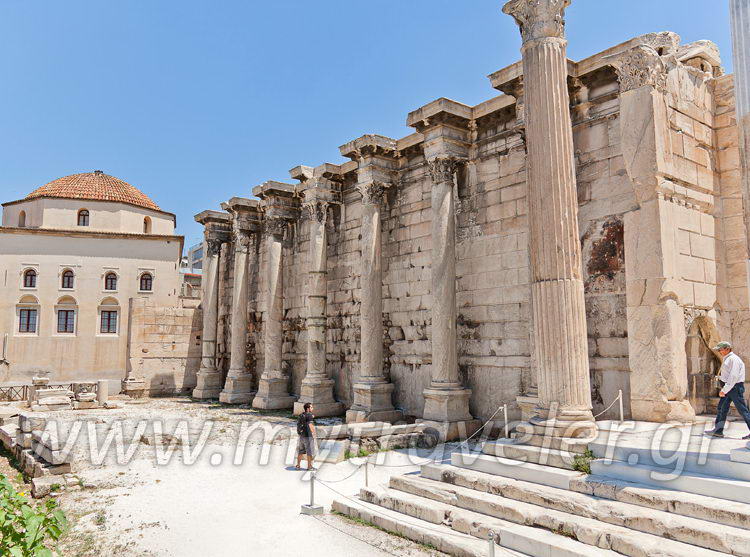Description
It was built in A.D. 132 by emperor Hadrian, was destroyed by the Herulae in A.D. 267, and was subsequently incorporated into the Late Roman fortification wall. It was repaired by the Roman eparchus Herculius in A.D. 412, and in the 5th century the quatrefoil building of the Early Christian church was constructed in the centre of the peristyle court. After its destruction, a three-aisled basilica was erected on its ruins in the 7th century, which was in turn superseded by the single-aisled church of Megale Panaghia, in the 11th century.
During the Turkish occupation it became the seat of the Voevode (Governor) and in 1835, the barracks of king Otho were erected in the place of the Voevodalik.
The rectangular building of the Library comprises a Corinthian propylon on the west side, an open peristyle courtyard, three projecting conches on each of the long sides, a library, study and lecture halls.
The most important monuments of the site are:
Quatrefoil Building. The building with the four apses, dated to the 5th century A.D., was an Early Christian church with a peripteral narthex, exonarthex and a wide peristyle atrium on the west side.
Church of Megale Panaghia. The first church was a three-aisled basilica, built in the 7th century A.D. on the ruins of the quatrefoil building which had been destroyed in the 6th century A.D. The basilica was in its turn destroyed in the 11th century A.D. and a single-aisled church with a chapel to the north was erected in its place. It survived for centuries but was burnt down in 1885.
Ruins of a church. The north wall and remains of the sanctuary are preserved. The church lies to the north of the quatrefoil building and dates from the 17th century A.D.
Tickets
Full: €2, Reduced: €1
During the Turkish occupation it became the seat of the Voevode (Governor) and in 1835, the barracks of king Otho were erected in the place of the Voevodalik.
The rectangular building of the Library comprises a Corinthian propylon on the west side, an open peristyle courtyard, three projecting conches on each of the long sides, a library, study and lecture halls.
The most important monuments of the site are:
Quatrefoil Building. The building with the four apses, dated to the 5th century A.D., was an Early Christian church with a peripteral narthex, exonarthex and a wide peristyle atrium on the west side.
Church of Megale Panaghia. The first church was a three-aisled basilica, built in the 7th century A.D. on the ruins of the quatrefoil building which had been destroyed in the 6th century A.D. The basilica was in its turn destroyed in the 11th century A.D. and a single-aisled church with a chapel to the north was erected in its place. It survived for centuries but was burnt down in 1885.
Ruins of a church. The north wall and remains of the sanctuary are preserved. The church lies to the north of the quatrefoil building and dates from the 17th century A.D.
Tickets
Full: €2, Reduced: €1
Published: 7 Aug. 2011
Add to favorite
- Information -
| (+30)-2103-229-740 |
| odysseus.culture.gr |
| GPS Coordinates |
| 37.9754876 , 23.7257347 |
| 37° 58' 31,7554"N , 23° 43' 32,6449"E |
Where to stay
accommodations located nearby
More Holiday Ideas
what else you can see here around
